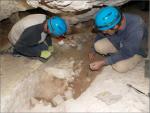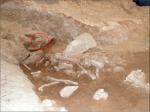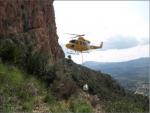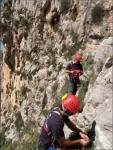Summary (English)
The cave of El Migdia Ravine is located in the sunny part of the Montgó at an altitude of approximately 375 meters above sea level. The cavity has three mouths, located on a cliff; consequently it is necessary to climb between 15 and 40 meters to reach the site. The most accessible point is the south-facing mouth; from there through a narrow gallery one reaches a small Central Chamber where prehistoric materials have been recovered. The current campaign has been focused on this area
From this Central Chamber were entered, through a narrow gallery, the chamber with rock paintings studied in the 1990s by J. Casabó, E. Martínez and J. Sampedro. Also from here, a narrow gallery opens onto a cave mouth into which the sun at sunset comes a few days of the year.
The excavation of sediments from the Central Chamber has led the location of anEneolithic burial, dated between the third and the second millennium BC. It is a secondary inhumation, displacing a previous burial whose bones were packed into a hole on the Central Chamber floor. Along with the bones was found a flint arrowhead and a few sherds from hand-built vessels. The whole tomb was covered by five limestone slabs.
In addition to this burial and its grave goods have been recovered archaeological materials as several sheets and a broken flint arrowhead and others shards.
To conclude we can say that works carried out for this first excavation campaign have allowed collecting exhaustive information about the site, in addition to the creation of a rigorous topography of the cave, photographic documentation of the pictorial set and the excavation of the Central Chamber. The anthropological study of the human remains is in progress: radiocarbon dating should provide an absolute chronology for this burial. In addition, analysis has started of the faunal remains and sediments in order to understand the contemporary environement.
(translation by Esther Casares Carmona)
- Juan de Dios Boronat Soler y Joaquim Bolufer Marqués
Director
- Joaquim Bolufer Marqués, Juan de Dios Boronat Soler, Marco A. Esquembre Bebia y Jorge A. Soler Díaz
Team
- Museo Arqueológico y Etnográfico Municipal “Soler Blasco”
Research Body
- ARPA Patrimonio, S.L.
- Colegio Oficial de Doctores y Licenciados en Filosofía y Letras y en Ciencias de Alicante - Sección de Arqueología
Funding Body
- Fundación Cultural CIRNE de Jávea






![Download [PDF]](/excavation/skins/fasti/images/results/download_sml.png)


